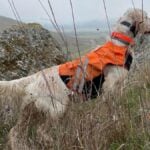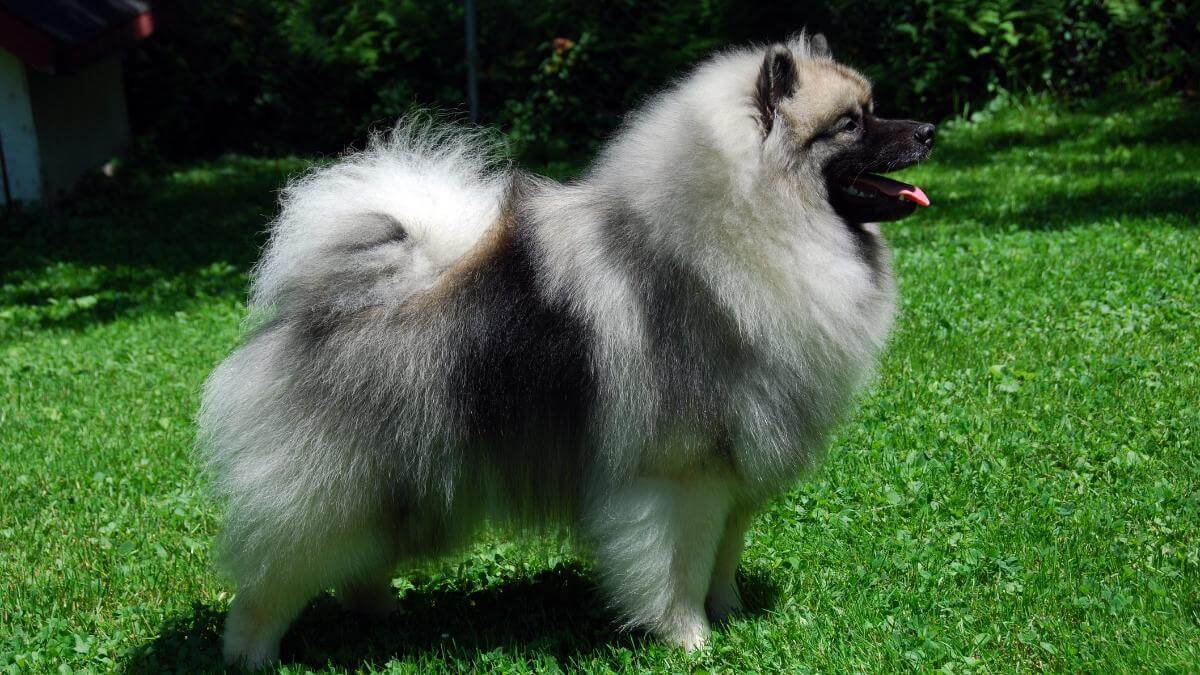
Home » How to Judge a Keeshond

This article was originally published in Showsight Magazine, August 2020 issue.
I am writing this article to help judges new to our breed as well as the more experienced judge who needs to learn the finer points of judging the Keeshond. This describes the basics of the judging procedure, but with the Keeshond Breed Standard explained in detail. So, ask your ring steward to bring in the dogs in catalog order. Line them up on one side of the ring. Look over the exhibits. You want the Keeshond to look balanced, short-coupled, square appearing, head and neck up over the backline, tail tightly curled over the back and legs under them, not overextended. You want to see males 18″ at the shoulder and females 17″. One inch variance either way is acceptable. Instruct the group to travel around the ring.
You want a Keeshond to glide smoothly with the head carriage above the topline with no bouncing or jerking movement, tail carried over the back, moving at a slow trot with moderate reach and drive. If you have one exhibit, please allow them to go around the ring before you put them on the ramp. We are a mandatory ramp breed! Have them proceed to the ramp. The ramp is there for examination only! Keeshonds are not to be judged for alertness, ear carriage, or attitude on the ramp. Survey the outline of the dog presented. Again, you want to see a pleasing, balanced silhouette; neck and head carriage above the topline. Legs should be under the dog, not extended. You want to see a square appearing dog. The coloring should be dramatic with definite shoulder markings with a black saddle. The neck ruff is a mixture of silver and gray and should be profuse.
Tail and pants are silver. Observation of chalking and dyeing the coat should be done at this time. Approach from the front to observe the head and front-end assembly. The head should be examined first. You want to see a nice wedge shape and a good stop. Please feel for that stop as some Keeshond have an abundance of hair and it could hide the lack of the stop. You want a nice dark brown to black almond shaped eye with proper spectacles. “Spectacles are the Hallmark of our breed.” Spectacles are a fine, black line around the orbital area that extends from the corner of the eye which then flares up to the outside of the ear. Some handlers get carried away with markers. Please check to see that the spectacle lines aren’t enhanced. Ears should be triangular in shape and set well on the head with the tips extending upward. Ears are black and should not be trimmed. Next, check the bite. You want to see a scissors bite. You have the option of checking the bite now or after you have entirely gone over the dog.
Regardless, the Keeshond should have a scissors bite. They should also have a black muzzle with dark pigmentation on lips and gums. Sometimes with age, you will see white on the muzzle. Check to make sure that there is pigmentation under the hairs. White muzzles could indicate mismarks. Pure black muzzles could indicate color enhancement. Next, check for the posternum. It should be obvious, but not protruding. You want to see sufficient width between the legs that is in balance with the dog. Check the amount of bone. This should be in balance with the dog. All legs should be straight seen from any angle. Walk around the side of the dog and place your hand on the withers. Find the width of the withers to determine if it is sufficient. Follow your hand down to the point of shoulder and from there to the elbow joint. You should feel that the elbows are close to the well-rounded rib cage. The length of the shoulder, upper arm and elbow to ground should all be the same. Elbows should be directly below the withers. From there, feel the backbone and loin area. A Keeshond should have a short loin and, ideally, the topline should slope slightly to the rear.
The pelvis, upper thigh and lower thigh should all be the same length, and attached to hocks well let down and perpendicular to the ground. The hocks should not extend past the point of the pelvic bone. The tail should be tight and directly over the back. The tail should not fall to either side, it should be placed directly over the back and curl at the end. The end of the tail is black tipped. (In all the years that I’ve judged and had Keeshond, I’ve never found one that wasn’t black tipped.) Donut tails and tea cup tails are not desired. Keeshond do not like their tails uncurled. So, if you wish to check the tip, please do it carefully. When the tail is uncurled you will see a nest. This is an indication that the tail is tightly curled. After the dog is examined on the ramp, allow the handler to present the dog on a free stack. Now is the time to judge attitude and showmanship. Allow the handler to show the expression and ear placement of the dog. Then, have them move out and back on a loose lead. A Keeshond should move straight and sharp.
They should not paddle, pound, or have a hackney gait. They will converge slightly with speed. The Keeshond should not be allowed to move at an accelerated speed. A nice slow trot is desired. Have the dog free stack, again seeing the headpiece with ears erect; and stacking properly with legs under the dog, not extended behind the tail. Legs are straight seen from any angle. Then have the dog go around the ring to the end of the line. I like to see a Keeshond hold its carriage when moving around the ring; head above the back topline, not dropping and not below the backline. You want to see a smooth gait, not bouncing or pounding. I’ve told many that if you doubt the movement, observe the coat. If you see the coat swishing and bouncing, something is not correct in the structure of the dog. Trimming! Our standard states that trimming is not permissible and should be severely penalized. However, we are allowed to trim whiskers, front and rear feet, hocks and pasterns. Slight trimming around the anus for cleanliness is permissible. This is where it gets ticklish! I would estimate that every dog in the ring is trimmed to some degree. This was put in our standard when breeders and handlers were trimming; totally sculpting their dogs. We didn’t want that.
This is a natural breed and we want them to be shown in a natural state. Tidying in areas might be visible, but should not be obvious. However, if you look at a Keeshond and every hair is in place and you see a perfect outline, more often than not, that dog has been overly trimmed and you should take that into consideration and judge accordingly. Remember, there is no perfect dog! However, please don’t penalize the dog when the handler is at fault. With regards to coat coloring, a Keeshond is dramatically colored and is basically silver and black. You want to see clear coloring with no smuttiness. Clean feet are desired. Penciling is acceptable on the feet. Note that a Keeshond puppy at six months of age probably won’t have any coloring in yet. You might see one that is completely beige with some black guard hairs protruding from its back.
This is normal for this age. However, you want to see a black muzzle, spectacles, and black tipped ears to some degree at this age. This coloring increases with age and should be in around nine months of age. I have seen dozens of judges go to their Breed Standard when confronted with a dog of this age to see what to do with this puppy. Unfortunately, this is not covered extensively in our standard and causes some confusion for judges new to our breed. Coat texture should be straight, harsh, standing well out from a thick, downy undercoat. Coat texture is of paramount importance. Silky coats will feel extremely soft to the touch and will not stand out from the body. Wavy and curly coats are very incorrect. If the coat parts down the middle of the back it can mean that the dog lacks proper coat texture or the dog is out of coat. When examining the coat, don’t be afraid to get into that coat and feel the dog’s texture and structure. A Keeshond coat should bounce back into shape with one shake. Coat length: As mentioned, a six-month-old puppy will not have its full adult coat in. This will come as the dog ages.
A male Keeshond will typically have more coat than our bitches. They should be presented with a full neck ruff, profuse pants and tail. Keeshond bitches typically have less coat and a tightly fitted coat. They should not be penalized for this. However, you will also see bitches having as much coat as their counterparts which is perfectly acceptable and should be applauded. Bitches lose their coat when they come in season so, at times, they will be what is referred to as “out of coat.” However, when you compare an adult male to an adult female, a male should definitely portray a masculine look and a bitch should portray a feminine one. There should be no questions of deciding which sex they are when looking at one or the other. In closing, when you have picked your Best of Breed, I hope you have chosen a dog that free stacks properly, has a beautiful, dramatically marked coat, lovely silhouette, correct spectacles, a beautiful headpiece, and a dog that travels around the ring with his head up moving with grace.
A word to the wise: Please do not talk to our Keeshond when they are on the ramp. They think that this gives them the right to wiggle and move out of their stack and possibly lick you. So, if you do, get ready for that kiss. Another suggestion…Keeshonds aren’t robots and we do not expect them to stand with ears up all the time in the ring. Once you’ve seen proper ear placement, go on to other important points. I hope that this gives you some idea on how to judge a Keeshond. I also hope that you will learn to love this breed like I do. Happy judging. For any questions or further information please contact me or check my website at windriftkeeshond.com